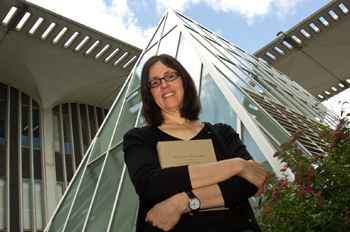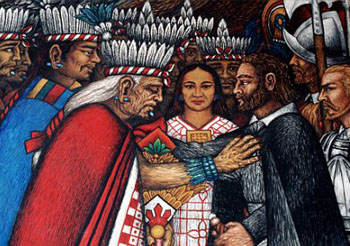Burkhart Breathes Life into Christian Dramas from the Aztecs
 |
Professor of Anthropology Louise M. Burkhart tutors graduate students in the language of the Aztecs. (Photo Mark Schmidt) |
It is satisfying for Professor of Anthropology Louise M. Burkhart to see her four-volume set lined up on her desk, now that Nahuatl Theater, Vol. 4: Nahua Christianity in Performance has been published by University of Oklahoma Press. However, she's not done with Nahuatl theater.
Nahuatl was the language of the Aztecs, and has been spoken in Central Mexico since the 7th century A.D. The Mexican census of 2000 counted nearly 1.5 million speakers in a wide band across central Mexico. The English words tomato, avocado, coyote, and chocolate had their origins in Nahuatl and were indigenous to Central Mexico.
Burkhart, who tutors graduate students in Nahuatl language, is an expert on how Aztec communities dramatized Christian legends in their own way to reinterpret the Spanish Conquest.
This concluding volume, produced with coeditor Barry D. Sell, contains a rich collection of 18th-century Christian-themed dramatizations performed in the Aztec language. Of the seven scripts, plus a fragment of an eighth, five have never been published before.
"It's exciting to work with materials no one's ever analyzed before, and make them available to other researchers," Burkhart said. "You're reading something no one's really looked at for hundreds of years, and bringing it back to life."
The plays tell Christian stories, but when Nahua actors performed them they became part of native ritual life, which focused on channeling sacred forces into the community and renewing the contracts between the people and their gods (or Christian saints).
"Pre-Columbian religion centered on ritual performances, and on all the preparations and regalia that went with them. For Nahua actors to play the parts of Jesus, the Virgin Mary, and so on � even the demon characters � was empowering because they, in a sense, temporarily became these figures, bringing the sacred stories to life in the ritual centers of their own towns, with costumes, props, music, even fireworks," said Burkhart, who earned a Ph.D. at Yale. "You can imagine how much more compelling this was than listening to Spanish priests try to preach sermons in Nahuatl."
 |
A mural in Tiaxcala, Mexico, depicting the Aztecs greeting Cortes.
|
The play scripts were kept in native communities, handed down, and recopied over generations. "Tragically, in the 18th century there were campaigns to suppress native theater and some of the manuscripts were confiscated," said Burkhart, who joined UAlbany in 1990 because of its strong Mesoamerican focus. Ironically, some of the scripts that we have today were taken from Nahuas at this time.
One of Burkhart's next projects is an early colonial pictorial catechism that belonged to descendants of the Aztec emperor Montezuma. These manuscripts used picture writing to present the Christian catechism, building on the pre-Columbian Aztec pictorial writing systems.
"I'm reconstructing the Nahuatl text that the pictures represent in order to analyze how the writing system worked and exactly how the artist expressed Christian concepts in pictures�these concepts having already been adapted and altered as they came into the Nahuatl language," said Burkhart, who is collaborating with art historian Elizabeth Boone of Tulane on the project.
![]() For more news, subscribe to UAlbany's RSS headline feeds
For more news, subscribe to UAlbany's RSS headline feeds


